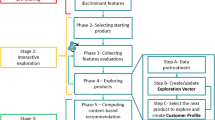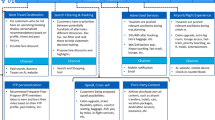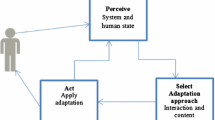Abstract
In recent years, recommender systems have become necessary in overcoming the challenges related to the incredible growth of information. They are used in a wide range of contexts and applications, mainly as prediction tools for customer interest, designed to help customers decide, compare, discover and explore products (Meyer in Recommender systems in industrial contexts, Sciences et Technologies de l’Information, Grenoble, 2012). Therefore, research in the field has focused on improving the efficiency of data processing for instant and accurate recommendations. Recommendation of products, accordingly, does not take into consideration supply chain constraints for deliveries. This can lead to recommendations for products that can be costly or too long to ship to the customer, resulting in an avoidable increase in the stress on the supply chain. This paper addresses the problem of considering delivery constraints in product recommendations. The objective is to shift demand toward products that can be delivered using the current network state without additional resources in a given time window, perimeter and with a minimum acceptable profit, in the context of e-commerce. To achieve this goal, we propose a methodology to adjust product recommendations in order to shift customers’ interests towards particular products with consideration for remaining unit loads of scheduled deliveries. For this, quasireal-time information about the supply chain is taken into consideration to improve the number of shippable products in the recommendation list, resulting in a possible improvement in truck-load utilization, lower operation costs and reduced lead-times for delivery. This method works in two stages: the first stage is the computation of the recommendation with traditional recommendation systems, and the second stage is recommendation adjustments in four phases that consider the evaluation of active trucks, evaluation of physical constraints for transportation, evaluation of the profits associated with adding a pickup/delivery to a scheduled tour for each recommended item and adjustment of recommendation scores. A sensitivity analysis of the impact of the recommendation adjustment on the recommendation list has been conducted for each of the parameters considered in the proposed method: time window, perimeter radius and minimum acceptable profit. Various experimental results prove that the method permits increasing the number of recommended products that can be shipped using the available resources within a given perimeter radius, time window and minimum profit.









Similar content being viewed by others
References
Abate, M. (2014). Determinants of capacity utilisation in road freight transportation. Journal of Transport Economics and Policy, 48(1), 137–152.
Abolghasemi, M., Gerlach, R., Tarr, G., & Beh, E. (2019). Demand forecasting in supply chain: The impact of demand volatility in the presence of promotion. arXiv preprint arXiv:1909.13084.
Adomavicius, G., & Tuzhilin, A. (2011). Context-aware recommender systems. In Recommender systems handbook (pp. 217–253). Springer.
Adomavicius, G., & Tuzhilin, A. (2005). Toward the next generation of recommender systems: A survey of the state-of-the-art and possible extensions. IEEE Transactions on Knowledge & Data Engineering, 6, 734–749.
Aguilar, J., Valdiviezo-Díaz, P., & Riofrio, G. (2017). A general framework for intelligent recommender systems. Applied computing and informatics, 13(2), 147–160.
Anand, N., & Grover, N. (2015). Measuring retail supply chain performance: Theoretical model using key performance indicators (kpis). Benchmarking: An International Journal, 22(1), 135–166.
Azi, N., Gendreau, M., & Potvin, J. Y. (2012). A dynamic vehicle routing problem with multiple delivery routes. Annals of Operations Research, 199(1), 103–112.
Baldacci, R., Battarra, M., & Vigo, D. (2008). Routing a heterogeneous fleet of vehicles. In The vehicle routing problem: latest advances and new challenges (pp. 3–27). Springer.
Ballot, E., Fontane, F., et al. (2008). Rendement et efficience du transport: Un nouvel indicateur de performance. Revue française de gestion industrielle, 27(2), 41–55.
Barla, P., Bolduc, D., Boucher, N., & Watters, J. (2006). Analyse économétrique du taux de chargement des camions se déplaçant au québec. Gouvernement du Quebec, Ministeres des Communications: Tech. rep.
Barragáns-Martínez, A. B., Costa-Montenegro, E., Burguillo, J. C., Rey-López, M., Mikic-Fonte, F. A., & Peleteiro, A. (2010). A hybrid content-based and item-based collaborative filtering approach to recommend tv programs enhanced with singular value decomposition. Information Sciences, 180(22), 4290–4311.
Belmecheri, F., Prins, C., Yalaoui, F., & Amodeo, L. (2013). Particle swarm optimization algorithm for a vehicle routing problem with heterogeneous fleet, mixed backhauls, and time windows. Journal of Intelligent Manufacturing, 24(4), 775–789.
Benaini, A., Berrajaa, A., & Daoudi, E.M. (2017). Parallel implementation of the multi capacity vrp on gpu. In Europe and MENA cooperation advances in information and communication technologies (pp. 353–364). Springer.
Bobadilla, J., Ortega, F., Hernando, A., & Gutiérrez, A. (2013). Recommender systems survey. Knowledge-Based Systems, 46, 109–132.
Braunscheidel, M. J., & Suresh, N. C. (2009). The organizational antecedents of a firm’s supply chain agility for risk mitigation and response. Journal of Operations Management, 27(2), 119–140.
Burke, R. (2002). Hybrid recommender systems: Survey and experiments. User Modeling and User-adapted Interaction, 12(4), 331–370.
Calvet, L., Ferrer, A., Gomes, M. I., Juan, A. A., & Masip, D. (2016). Combining statistical learning with metaheuristics for the multi-depot vehicle routing problem with market segmentation. Computers & Industrial Engineering, 94, 93–104.
Cárdenas-Barrón, L. E., González-Velarde, J. L., Treviño-Garza, G., & Garza-Nuñez, D. (2019). Heuristic algorithm based on reduce and optimize approach for a selective and periodic inventory routing problem in a waste vegetable oil collection environment. International Journal of Production Economics, 211, 44–59.
Carić, T., Galić, A., Fosin, J., Gold, H., & Reinholz, A. (2008). A modelling and optimization framework for real-world vehicle routing problems. In Vehicle routing problem (pp. 15–16). InTech.
Chae, B. (2009). Developing key performance indicators for supply chain: An industry perspective. Supply Chain Management: An International Journal, 14(6), 422–428.
Chen, L. S., Hsu, F. H., Chen, M. C., & Hsu, Y. C. (2008). Developing recommender systems with the consideration of product profitability for sellers. Information Sciences, 178(4), 1032–1048.
Choi, K., Yoo, D., Kim, G., & Suh, Y. (2012). A hybrid online-product recommendation system: Combining implicit rating-based collaborative filtering and sequential pattern analysis. Electronic Commerce Research and Applications, 11(4), 309–317.
Christopher, M. (2016). Logistics & supply chain management (5th ed.). Harlow: FT Publishing International.
Coelho, L. C., & Laporte, G. (2014). Improved solutions for inventory-routing problems through valid inequalities and input ordering. International Journal of Production Economics, 155, 391–397.
Cordeau, J. F. (2000). The VRP with time Windows. Montréal: Groupe d’études et de recherche en analyse des décisions.
Cordeau, J. F., Laporte, G., & Mercier, A. (2001). A unified tabu search heuristic for vehicle routing problems with time windows. Journal of the Operational Research Society, 52(8), 928–936.
Dadouchi, C., & Agard, B. (2018). Lowering penalties related to stock-outs by shifting demand in product recommendation systems. Decision Support Systems, 114, 61–69.
Dantzig, G. B., & Ramser, J. H. (1959). The truck dispatching problem. Management Science, 6(1), 80–91.
Dechampai, D., Tanwanichkul, L., Sethanan, K., & Pitakaso, R. (2017). A differential evolution algorithm for the capacitated vrp with flexibility of mixing pickup and delivery services and the maximum duration of a route in poultry industry. Journal of Intelligent Manufacturing, 28(6), 1357–1376.
Erdougan, G. (2017). An open source spreadsheet solver for vehicle routing problems. Computers & Operations Research, 84, 62–72.
Farahani, R., Rezapour, S., & Kardar, L. (2011). Logistics operations and management: Concepts and models. Amsterdam: Elsevier.
Gligor, D. M., Esmark, C. L., & Holcomb, M. C. (2015). Performance outcomes of supply chain agility: When should you be agile? Journal of Operations Management, 33, 71–82.
Gligor, D. M., & Holcomb, M. C. (2012). Understanding the role of logistics capabilities in achieving supply chain agility: A systematic literature review. Supply Chain Management: An International Journal, 17(4), 438–453.
Gligor, D. M., Holcomb, M. C., & Stank, T. P. (2013). A multidisciplinary approach to supply chain agility: Conceptualization and scale development. Journal of Business Logistics, 34(2), 94–108.
Gunasekaran, A., Lai, Kh, & Cheng, T. E. (2008). Responsive supply chain: A competitive strategy in a networked economy. Omega, 36(4), 549–564.
Gunasekaran, A., Patel, C., & Tirtiroglu, E. (2001). Performance measures and metrics in a supply chain environment. International Journal of Operations & Production Management, 21(1/2), 71–87.
Gunasekaran, A., & Yusuf, Y. (2002). Agile manufacturing: A taxonomy of strategic and technological imperatives. International Journal of Production Research, 40(6), 1357–1385.
Guo, J., Gao, Z., Liu, N., & Wu, Y. (2018). Recommend products with consideration of multi-category inter-purchase time and price. Future Generation Computer Systems, 78, 451–461.
Herlocker, J. L., Konstan, J. A., Terveen, L. G., & Riedl, J. T. (2004). Evaluating collaborative filtering recommender systems. ACM Transactions on Information Systems (TOIS), 22(1), 5–53.
Homberger, J., & Gehring, H. (1999). Two evolutionary metaheuristics for the vehicle routing problem with time windows. INFOR: Information Systems and Operational Research, 37(3), 297–318.
Hooper, A., & Murray, D. (2018). An analysis of the operational costs of trucking: 2018 update. Tech. rep. New York: American Transportation Research Institute.
Iori, M., & Martello, S. (2010). Routing problems with loading constraints. Top, 18(1), 4–27.
Jiang, Y., Shang, J., & Liu, Y. (2010). Maximizing customer satisfaction through an online recommendation system: A novel associative classification model. Decision Support Systems, 48(3), 470–479.
Kallehauge, B., Larsen, J., Madsen, O.B., & Solomon, M. M. (2005). Vehicle routing problem with time windows. In Column generation (pp. 67–98). Springer.
Kohl, N., Desrosiers, J., Madsen, O. B., Solomon, M. M., & Soumis, F. (1999). 2-path cuts for the vehicle routing problem with time windows. Transportation Science, 33(1), 101–116.
Kumar, V., Batista, L., & Maull, R. (2011). The impact of operations performance on customer loyalty. Service Science, 3(2), 158–171.
Levinson, M. (2016). The box: How the shipping container made the world smaller and the world economy bigger-with a new chapter by the author. Princeton: Princeton University Press.
Lü, L., Medo, M., Yeung, C. H., Zhang, Y. C., Zhang, Z. K., & Zhou, T. (2012). Recommender systems. Physics Reports, 519(1), 1–49.
MacKenzie, I., Meyer, C., & Noble, S. (2013). How retailers can keep up with consumers. Tech. rep. New York: McKinsey & Company.
Mentzer, J. T., DeWitt, W., Keebler, J. S., Min, S., Nix, N. W., Smith, C. D., et al. (2001). Defining supply chain management. Journal of Business logistics, 22(2), 1–25.
Meyer, F. (2012). Recommender systems in industrial contexts. PhD thesis, Universite de Grenoble, Ecole Doctorale Mathematiques, Sciences et Technologies de l’Information, Grenoble, France.
Montreuil, B. (2011). Toward a physical internet: Meeting the global logistics sustainability grand challenge. Logistics Research, 3(2–3), 71–87.
Nha, V. T. N., Djahel, S., & Murphy, J. (2012). A comparative study of vehicles’ routing algorithms for route planning in smart cities. In 2012 First international workshop on vehicular traffic management for smart cities (VTM) (pp. 1–6). IEEE.
Pathak, B., Garfinkel, R., Gopal, R. D., Venkatesan, R., & Yin, F. (2010). Empirical analysis of the impact of recommender systems on sales. Journal of Management Information Systems, 27(2), 159–188.
Polat, O., Kalayci, C. B., Kulak, O., & Günther, H. O. (2015). A perturbation based variable neighborhood search heuristic for solving the vehicle routing problem with simultaneous pickup and delivery with time limit. European Journal of Operational Research, 242(2), 369–382.
Pollaris, H., Braekers, K., Caris, A., Janssens, G. K., & Limbourg, S. (2015). Vehicle routing problems with loading constraints: State-of-the-art and future directions. OR Spectrum, 37(2), 297–330.
Powell, W. B. (1996). A stochastic formulation of the dynamic assignment problem, with an application to truckload motor carriers. Transportation Science, 30(3), 195–219.
Pu, P., Chen, L., & Hu, R. (2011). A user-centric evaluation framework for recommender systems. In Proceedings of the fifth ACM conference on Recommender systems (pp. 157–164). ACM, Chicago, Illinois, USA
Rey, A., Prieto, M., Gómez, J. I., Tenllado, C., & Hidalgo, J. I. (2018). A cpu-gpu parallel ant colony optimization solver for the vehicle routing problem. In International conference on the applications of evolutionary computation (pp. 653–667). Springer.
Ricci, F., Rokach, L., & Shapira, B. (2015). Recommender systems: Introduction and challenges. In Recommender systems handbook (pp. 1–34). Springer.
Rochat, Y., & Taillard, É. D. (1995). Probabilistic diversification and intensification in local search for vehicle routing. Journal of Heuristics, 1(1), 147–167.
Ruan, Q., Zhang, Z., Miao, L., & Shen, H. (2013). A hybrid approach for the vehicle routing problem with three-dimensional loading constraints. Computers & Operations Research, 40(6), 1579–1589.
Sánchez-Arocha, O., Treviño-Garza, G., Cárdenas-Barrón, L. E., & Meneses-Preciado, C. V. (2018). A framework for solving routing problems for small and medium size companies. International Journal of Applied and Computational Mathematics, 4(3), 94.
Sarraj, R., Ballot, E., Pan, S., & Montreuil, B. (2014). Analogies between internet network and logistics service networks: Challenges involved in the interconnection. Journal of Intelligent Manufacturing, 25(6), 1207–1219.
Schafer, J. B., Konstan, J., & Riedl, J. (1999). Recommender systems in e-commerce. In Proceedings of the 1st ACM conference on electronic commerce (pp. 158–166). ACM, Denver, CO, USA.
Shani, G., & Gunawardana, A. (2011). Evaluating recommendation systems. In Recommender systems handbook (pp. 257–297). Springer.
Sharma, A., Grewal, D., & Levy, M. (1995). The customer satisfaction/logistics interface. Journal of Business Logistics, 16(2), 1.
Simchi-Levi, D., Kaminsky, P., Simchi-Levi, E., & Shankar, R. (2008). Designing and managing the supply chain: Concepts, strategies and case studies. Tata McGraw-Hill Education, chap Introduction to Supply Chain Management, p 99.
Soonpracha, K., Mungwattana, A., & Manisri, T. (2015). A re-constructed meta-heuristic algorithm for robust fleet size and mix vehicle routing problem with time windows under uncertain demands. In Proceedings of the 18th Asia Pacific symposium on intelligent and evolutionary systems-volume 2 (pp. 347–361). Springer.
Stachowiak, A., & Oleśków-Szłapka, J. (2018). Agility capability maturity framework. Procedia Manufacturing, 17, 603–610.
Stadtler, H. (2008). Supply chain management—An overview. In Supply chain management and advanced planning (pp 9–36). Springer
Stadtler, H. (2005). Supply chain management and advanced planning–basics, overview and challenges. European Journal of Operational Research, 163(3), 575–588.
Su, X., & Khoshgoftaar, TM. (2009). A survey of collaborative filtering techniques. Advances in Artificial Intelligence.
Thomas, D. J., & Griffin, P. M. (1996). Coordinated supply chain management. European Journal of Operational Research, 94(1), 1–15.
Van der Vorst, J. (2004). Supply chain management: Theory and practices. In Bridging theory and practice, reed business (pp. 105–128).
Van Duin, J., Wiegmans, B., Tavasszy, L., Hendriks, B., & He, Y. (2018). Evaluating new participative city logistics concepts: The case of cargo hitching. In 3rd International conference green cities—green logistics for Greener cities. IFORS, Szczecin, Poland.
Vozalis, M. G., & Margaritis, K. G. (2007). Using svd and demographic data for the enhancement of generalized collaborative filtering. Information Sciences, 177(15), 3017–3037.
Wang, G., Gunasekaran, A., Ngai, E. W., & Papadopoulos, T. (2016). Big data analytics in logistics and supply chain management: Certain investigations for research and applications. International Journal of Production Economics, 176, 98–110.
Wong, E. Y., Tai, A. H., & Zhou, E. (2018). Optimising truckload operations in third-party logistics: A carbon footprint perspective in volatile supply chain. Transportation Research Part D: Transport and Environment, 63, 649–661.
Wu, M. L., Chang, C. H., & Liu, R. Z. (2014). Integrating content-based filtering with collaborative filtering using co-clustering with augmented matrices. Expert Systems with Applications, 41(6), 2754–2761.
Xu, Z., Elomri, A., Pokharel, S., & Mutlu, F. (2019). A model for capacitated green vehicle routing problem with the time-varying vehicle speed and soft time windows. Computers & Industrial Engineering, 137, 106011.
Yang, Z., Wu, B., Zheng, K., Wang, X., & Lei, L. (2016). A survey of collaborative filtering-based recommender systems for mobile internet applications. IEEE Access, 4, 3273–3287.
Yao, X., Zhou, J., Lin, Y., Li, Y., Yu, H., & Liu, Y. (2019). Smart manufacturing based on cyber-physical systems and beyond. Journal of Intelligent Manufacturing, 30(8), 2805–2817.
Zhang, M., Huang, G. Q., Xu, S. X., & Zhao, Z. (2019). Optimization based transportation service trading in b2b e-commerce logistics. Journal of Intelligent Manufacturing, 30(7), 2603–2619.
Acknowledgements
The authors would like to acknowledge our industrial partner (Air Liquide) and the National Sciences and Engineering Research Council of Canada (NSERC) for funding this work under Grant RDCPJ 492021-15, and for providing other support for this research.
Author information
Authors and Affiliations
Corresponding author
Additional information
Publisher's Note
Springer Nature remains neutral with regard to jurisdictional claims in published maps and institutional affiliations.
Rights and permissions
About this article
Cite this article
Dadouchi, C., Agard, B. Recommender systems as an agility enabler in supply chain management. J Intell Manuf 32, 1229–1248 (2021). https://doi.org/10.1007/s10845-020-01619-5
Received:
Accepted:
Published:
Issue Date:
DOI: https://doi.org/10.1007/s10845-020-01619-5




